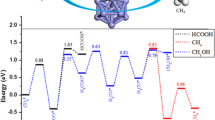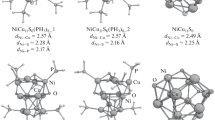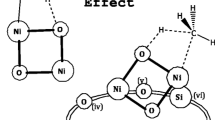Abstract
Methane activation is a pivotal step in the application of natural gas converting into high-value added chemicals via methane steam/dry reforming reactions. Ni element was found to be the most widely used catalyst. In present work, methane activation on MgO supported Ni-M (M = Fe, Co, Cu, Pd, Pt) cluster was explored through detailed density functional theory calculations, compared to pure Ni cluster. CH4 adsorption on Cu promoted Ni cluster requires overcoming an energy of 0.07 eV, indicating that it is slightly endothermic and unfavored to occur, while the adsorption energies of other promoters M (M = Fe, Co, Pd and Pt) are all higher than that of pure Ni cluster. The role of M on the first C-H bond cleavage of CH4 was investigated. Doping elements of the same period in Ni cluster, such as Fe, Co and Cu, for C-H bond activation follows the trend of the decrease of metal atom radius. As a result, Ni-Fe shows the best ability for C-H bond cleavage. In addition, doping the elements of the same family, like Pd and Pt, for CH4 activation is according to the increase of metal atom radius. Consequently, C-H bond activation demands a lower energy barrier on Ni-Pt cluster. To illustrate the adsorptive dissociation behaviors of CH4 at different Ni-M clusters, the Mulliken atomic charge was analyzed. In general, the electron gain of CH4 binding at different Ni-M clusters follows the sequence of Ni-Cu (−0.02 e) < Ni (−0.04 e) < Ni-Pd (−0.08 e) < Ni-Pt (−0.09 e) < Ni-Co (−0.10 e) < Ni-Fe (−0.12 e), and the binding strength between catalysts and CH4 raises with the CH4 electron gain increasing. This work provides insights into understanding the role of promoter metal M on thermal-catalytic activation of CH4 over Ni/MgO catalysts, and is useful to interpret the reaction at an atomic scale.

Similar content being viewed by others
References
Lin B, Kuang Y. Natural gas subsidies in the industrial sector in China: national and regional perspectives. Applied Energy, 2020, 260:114329
Dale S. BP Energy Outlook 2018. BP Website, 2018
Taifan W, Baltrusaitis J. CH4 conversion to value added products: potential, limitations and extensions of a single step heterogeneous catalysis. Applied Catalysis B: Environmental, 2016, 198: 525–547
Schwach P, Pan X, Bao X. Direct conversion of methane to value-added chemicals over heterogeneous catalysts: challenges and prospects. Chemical Reviews, 2017, 117(13): 8497–8520
Song Y, Ozdemir E, Ramesh S, Adishev A, Subramanian S, Harale A, Albuali M, Fadhel B A, Jamal A, Moon D, Choi S H, Yavuz C T. Dry reforming of methane by stable Ni-Mo nanocatalysts on single-crystalline MgO. Science, 2020, 367(6479): 777–781
Buelens L C, Galvita V V, Poelman H, Detavernier C, Marin G B. Super-dry reforming of methane intensifies CO2 utilization via Le Chatelier’s principle. Science, 2016, 354(6311): 449–152
Liu H, Wierzbicki D, Debek R, Motak M, Grzybek T, Da Costa P, Gálvez M E. La-promoted Ni-hydrotalcite-derived catalysts for dry reforming of methane at low temperatures. Fuel, 2016, 182: 8–16
Wang H, Blaylock D W, Dam A H, Liland S E, Rout K R, Zhu Y A, Green W H, Holmen A, Chen D. Steam methane reforming on a Ni-based bimetallic catalyst: density functional theory and experimental studies of the catalytic consequence of surface alloying of Ni with Ag. Catalysis Science & Technology, 2017, 7(8): 1713–1725
Niu J, Wang Y, Qi Y, Dam A H, Wang H, Zhu Y A, Holmen A, Ran J, Chen D. New mechanism insights into methane steam reforming on Pt/Ni from DFT and experimental kinetic study. Fuel, 2020, 266: 117143
Niu J, Ran J, Chen D. Understanding the mechanism of CO2 reforming of methane to syngas on Ni@Pt surface compared with Ni(111) and Pt(111). Applied Surface Science, 2020, 513: 145840
Niu J, Du X, Ran J, Wang R. Dry (CO2) reforming of methane over Pt catalysts studied by DFT and kinetic modeling. Applied Surface Science, 2016, 376: 79–90
Dębek R, Motak M, Duraczyska D, Launay F, Galvez M E, Grzybek T, Da Costa P. Methane dry reforming over hydrotalcite-derived Ni-MgAl mixed oxides: the influence of Ni content on catalytic activity, selectivity and stability. Catalysis Science & Technology, 2016, 6(17): 6705–6715
Li S, Gong J. Strategies for improving the performance and stability of Ni-based catalysts for reforming reactions. Chemical Society Reviews, 2014, 43(21): 7245–7256
Niu J, Liland S E, Yang J, Rout K R, Ran J, Chen D. Effect of oxide additives on the hydrotalcite derived Ni catalysts for CO2 reforming of methane. Chemical Engineering Journal, 2019, 377: 119763
Wei J M, Iglesia E. Isotopic and kinetic assessment of the mechanism of reactions of CH4 with CO2 or H2O to form synthesis gas and carbon on nickel catalysts. Journal of Catalysis, 2004, 224(2): 370–383
Foppa L, Margossian T, Kim S M, Müller C, Copéret C, Larmier K, Comas-Vives A. Contrasting the role of Ni/Al2O3 interfaces in water-gas shift and dry reforming of methane. Journal of the American Chemical Society, 2017, 139(47): 17128–17139
Niu J, Liu H, Jin Y, Fan B, Qi W, Ran J. Comprehensive review of Cu-based CO2 hydrogenation to CH3OH: insights from experimental work and theoretical analysis. International Journal of Hydrogen Energy, 2022, 47(15): 9183–9200
Marcinkowski M D, Darby M T, Liu J, Wimble J M, Lucci F R, Lee S, Michaelides A, Flytzani-Stephanopoulos M, Stamatakis M, Sykes E C H. Pt/Cu single-atom alloys as coke-resistant catalysts for efficient C-H activation. Nature Chemistry, 2018, 10(3): 325–332
Huang Y, Du J, Ling C, Zhou T, Wang S. Methane dehydrogenation on Au/Ni surface alloys—a first-principles study. Catalysis Science & Technology, 2013, 3(5): 1343–1354
Liu H, Yan R, Zhang R, Wang B, Xie K. A DFT theoretical study of CH4 dissociation on gold-alloyed Ni(111) surface. Journal of Natural Gas Chemistry, 2011, 20(6): 611–617
Niu J, Ran J, Du X, Qi W, Zhang P, Yang L. Effect of Pt addition on resistance to carbon formation of Ni catalysts in methane dehydrogenation over Ni-Pt bimetallic surfaces: a density functional theory study. Molecular Catalysis, 2017, 434: 206–218
Zhang M, Yang K, Zhang X, Yu Y. Effect of Ni(111) surface alloying by Pt on partial oxidation of methane to syngas: a DFT study. Surface Science, 2014, 630: 236–243
Bothra P, Pati S K. Improved catalytic activity of rhodium monolayer modified nickel (110) surface for the methane dehydrogenation reaction: a first-principles study. Nanoscale, 2014, 6(12): 6738–6744
Zhao Y, Li S, Sun Y. Theoretical study on the dissociative adsorption of CH4 on Pd-doped Ni surfaces. Chinese Journal of Catalysis, 2013, 34(5): 911–922
Li K, Li M, Wang Y, Wu Z. Theoretical study on the effect of Mn promoter for CO2 reforming of CH4 on the Ni(111) surface. Fuel, 2020, 274: 117849
Fan C, Zhu Y A, Xu Y, Zhou Y, Zhou X G, Chen D. Origin of synergistic effect over Ni-based bimetallic surfaces: a density functional theory study. Journal of Chemical Physics, 2012, 137(1): 014703
Roy G, Chattopadhyay A P. Dissociation of methane on Ni4 cluster—a DFT study. Computational & Theoretical Chemistry, 2017, 1106: 7–14
Jackson B, Nave S. The dissociative chemisorption of methane on Ni(100): reaction path description of mode-selective chemistry. Journal of Chemical Physics, 2011, 135(11): 114701
Cataphan R C, Oliveira A A M, Chen Y, Vlachos D G. DFT study of the water-gas shift reaction and coke formation on Ni(111) and Ni(211) surfaces. Journal of Physical Chemistry C, 2012, 116(38): 20281–20291
Wang Z, Cao X M, Zhu J, Hu P. Activity and coke formation of nickel and nickel carbide in dry reforming: a deactivation scheme from density functional theory. Journal of Catalysis, 2014, 311: 469–480
Payne M C, Teter M P, Allan D C, Arias T A, Joannopoulos J D. Iterative minimization techniques for ab initio total-nerryy calculations: molecular dynamics and conjugate gradients. Reviews of Modern Physics, 1992, 64(4): 1045–1097
Delley B. Fast calculation of electrostatics in crystals and large molecules. Journal of Physical Chemistry, 1996, 100(15): 6107–6110
Perdew J P, Burke K, Ernzerhof M. Generalized gradient approximation made simple. Physical Review Letters, 1996, 77(18): 3865–3868
Niu J, Ran J, Qi W, Ou Z, He W. Identification of active sites in CO2 activation on MgO supported Ni cluster. International Journal of Hydrogen Energy, 2020, 45(19): 11108–11115
Monkhorst H J, Pack J D. Special points for Brillouin-zone integrations. Physical Review. B, Solid State, 1976, 13(12): 5188–5192
Halgren T A, Lipscomb W N. The synchronous-transit method for determining reaction pathways and locating molecular transition states. Chemical Physics Letters, 1977, 49(2): 225–232
Niu J, Guo F, Ran J, Qi W, Yang Z. Methane dry (CO2) reforming to syngas (H2/CO) in catalytic process: from experimental study and DFT calculations. International Journal of Hydrogen Energy, 2020, 45(55): 30267–30287
Pan C, Guo Z, Dai H, Ren R, Chu W. Anti-sintering mesoporous Ni-Pd bimetallic catalysts for hydrogen production via dry reforming of methane. International Journal of Hydrogen Energy, 2020, 45(32): 16133–16143
Chaichi A, Sadrnezhaad S K, Malekjafarian M. Synthesis and characterization of supportless Ni-Pd-CNT nanocatalyst for hydrogen production via steam reforming of methane. International Journal of Hydrogen Energy, 2018, 43(3): 1319–1336
Niu J, Wang Y, Liland S E, Regli S K, Yang J, Rout K R, Luo J, Rønning M, Ran J, Chen D. Unraveling enhanced activity, selectivity, and coke-resistance of Pt-Ni bimetallic clusters in dry reforming. ACS Catalysis, 2021, 11(4): 2398–2411
Xie Z, Yan B, Lee J H, Wu Q, Li X, Zhao B, Su D, Zhang L, Chen J G. Effects of oxide supports on the CO2 reforming of ethane over Pt-Ni bimetallic catalysts. Applied Catalysis B: Environmental, 2019, 245: 376–388
Turap Y, Wang I, Fu T, Wu Y, Wang Y, Wang W. Co-Ni alloy supported on CeO2 as a bimetallic catalyst for dry reforming of methane. International Journal of Hydrogen Energy, 2020, 45(11): 6538–6548
Qiu H, Ran J, Niu J, Guo F, Ou Z. Effect of different doping ratios of Cu on the carbon formation and the elimination on Ni(111) surface: a DFT study. Molecular Catalysis, 2021, 502: 111360
Acknowledgments
The authors would like to thank the projects supported by the National Natural Science Foundation of China (Grant No. 52106179), the Fundamental Research Program of Shanxi Province, China (Grant No. 20210302124017), the Natural Science Foundation of Chongqing, China (Grant No. cstc2020jcyj-msxmX0454), the Scientific and Technological Activities for Overseas Students of Shanxi Province, China Grant No. 20200016).
Author information
Authors and Affiliations
Corresponding author
Electronic supplementary material
Rights and permissions
About this article
Cite this article
Niu, J., Liu, H., Jin, Y. et al. A density functional theory study of methane activation on MgO supported Ni9M1 cluster: role of M on C-H activation. Front. Chem. Sci. Eng. 16, 1485–1492 (2022). https://doi.org/10.1007/s11705-022-2169-8
Received:
Accepted:
Published:
Issue Date:
DOI: https://doi.org/10.1007/s11705-022-2169-8




